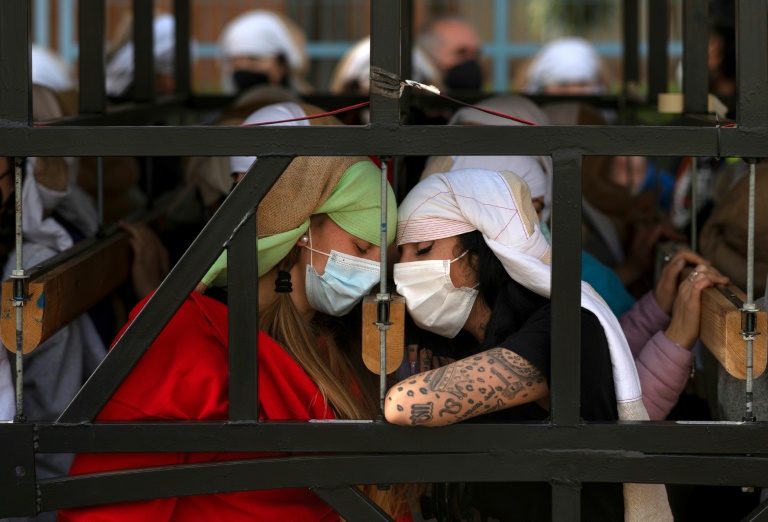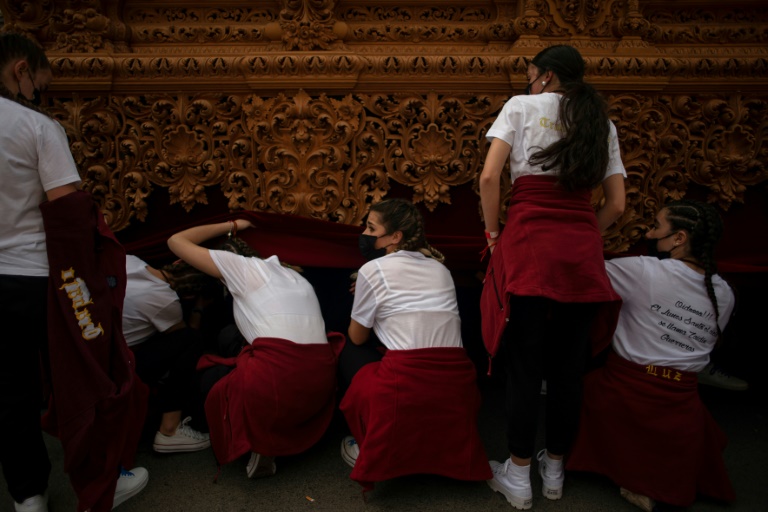Supported, advancing at a haunting pace, they carry on their necks a chariot of Christ and the Virgin weighing one and a half tons. In Spain, during Holy Week, women “costaleras” perform the same physical feat as men, but remain controversial.
From the tank that paces more than ten hours during the streets of Granada (south), only white shoes emerge. Below, behind curtains, fifty women, huddled in ten rows, whose vertebrae support the heavy beams of the frame.
After a two-year hiatus due to the pandemic, processions recreating the Passion and Resurrection of Christ resumed this week in Spain, marking the return of Nazarenes in conical hoods and “costaleros”, so called because they wrap around their head a jute fabric, the “costal”, equipped with a small pad to cushion the weight of the tanks.
A function reserved for men thirty years ago, when women only took part in processions to accompany them with a candle and a black mantilla on their head.
In Granada, the “Work and Light” brotherhood was one of the first to have a women’s team in the 1980s.
But at first, “it was not accepted, we spoke badly of women”, recalls Pilar del Carpio, a 45-year-old cashier and “costalera” since she was 13, who is proud to have been a “pioneer”.
Even today, out of the thirty or so brotherhoods in the city, only three or four have “costaleras”.
“There may be people who think it’s not normal, but since our body is capable of doing it, that we do it with conviction, I don’t see why there would be a difference”, insists María Auxiliadora Canca, 40, foreman of a brotherhood in Ronda, another Andalusian city, and driving school instructor.
– No women in Seville –
Unsuitable, too physical… The reasons given are not always clear, but Seville, “capital” of Holy Week, does not have any “costalera”, although the Church issued a decree in 2011 formulating the equality within the brotherhoods.

“A scandal”, according to Maribel Tortosa, 23, manager of the Instagram account “Costaleras por Sevilla”. “They say that a woman with a costal is ugly. But below a tank, you can’t see anything!”, she denounces.
In Granada, on the other hand, the inhabitants are no longer surprised to see these women, harnessed in support belts, training in the streets to lift a chariot weighted with concrete blocks weeks before Holy Week begins.
Three knocks on the knocker, the “costaleras” bend their legs and wedge the beams of the chariot on their cervicals before jumping in unison to lift it.
– Suffering and silence –
“Forward”, “we equalize”, “we expect, girls”: the convoy rushes to the sound of music and the leader. Fixed and intense gaze for some, eyes closed for others, the suffering is done in silence and rhythm.
The load “weighs more every hour”, despite the relief every 30 minutes during the procession, which began at 4 p.m. Monday and ended around 1 a.m., explains Rafael Pérez, foreman of the troop of 111 women.

Working with women “changes absolutely nothing. You just have to treat them with more tenderness,” he says.
Within the troop, Rocío Melguizo, 21, adjusts her step to that of her mother, Montse Ríos, just in front of her. At 47, Montse feels “still strong enough to go under”, she who has been a “costalera” since she was 19, when people’s minds were less open.
She is now in heaven to share this with her eldest and to have her other daughter “pipera”, that is to say responsible for giving water to the processionaries.
It was a first for 19-year-old Sandra Maldonado, who had been waiting “so long to be under.” “It’s a unique feeling”, she confides, while admitting, mischievously, to have already been small there, but “without carrying the weight so as not to get hurt”.
She recognizes that we do not look “at all” in the same way “costalero men and costalera women”, but when it comes to carrying the chariot, “it does not only take courage, but heart. And there’s no shortage of that.”
We would love to say thanks to the author of this short article for this amazing web content
In Spain, under the floats of Holy Week, women still contested – Teller Report
Check out our social media profiles along with other related pageshttps://nimblespirit.com/related-pages/

